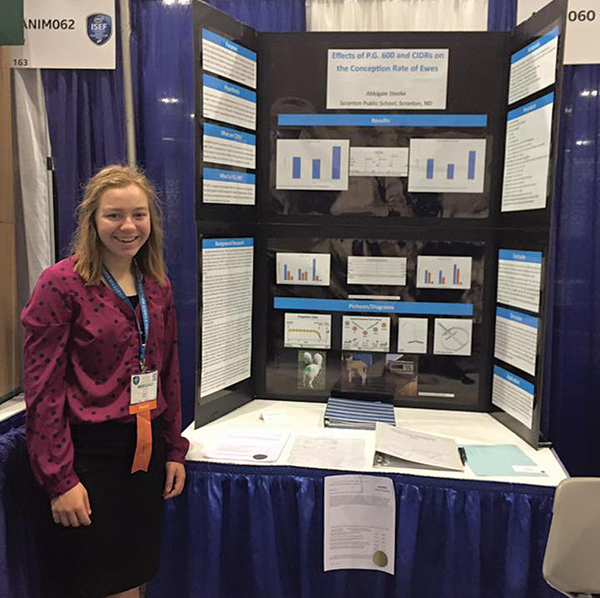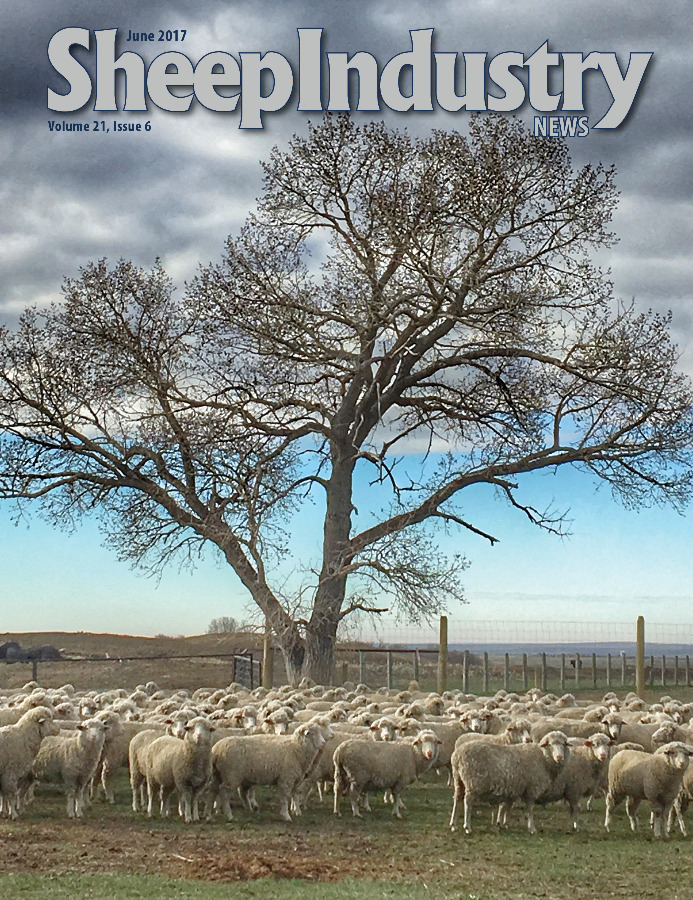Kyle Partain
Sheep Industry News Editor
Abbigale Steeke, a soon-to-be junior at Scranton (N.D.) Public School, earned a trip to the Intel International Science and Engineering Fair in Los Angeles, May 14-19, thanks to a science project that incorporated the family’s sheep flock.
Intel ISEF, a program of Society for Science & the Public, is the world’s largest international pre-college science competition. Each year, approximately 1,800 high school students from more than 75 countries, regions and territories are awarded the opportunity to showcase their independent research and compete for an average of $4 million in prizes.
Abbigale finished in the top two in her region to qualify for the trip, and is the first student since 1986 from the school to earn a spot in the prestigious science fair. She placed CIDRS (a progesterone product) in sheep and experimented with veterinarian-prescribed amounts of gonadotropin 600, also known as PG600, to determine its effect on the yield of her lamb crop.
 “I did this because there’s not a lot of information on sheep with a combination of CIDRS and PG600,” she said. “There’s a lot of things done on cows and sows, but not a lot published on sheep.”
“I did this because there’s not a lot of information on sheep with a combination of CIDRS and PG600,” she said. “There’s a lot of things done on cows and sows, but not a lot published on sheep.”
A fourth-generation sheep producer, Abbigale has plenty of sheep to work with. The family runs registered Dorset and Hampshires, as well as a commercial flock of Columbias and Rambouillets. She was also selected as a North Dakota Lamb and Wool Producers Association starter flock recipient a few years back.
The American Sheep Industry Association awarded Abbigale a $500 stipend to assist with travel expenses during her trip to ISEF, so I was anxious to check in with her after her return from the science fair. While she didn’t win an award at the science fair, she gained valuable experience that will help should she earn a return trip in the coming years.
“It was a lot of fun, and a real learning experience,” said Steeke after her first trip to the prestigious science fair. “I had nine judges, and they all knew what was happening and understood what I was trying to do. They were surprised that there wasn’t more done on sheep and PG600. They had some great suggestions about things I could have done to improve the project. I could have had a bigger sample size was one of their suggestions.”
Sheep industry veterans, of course, wouldn’t be surprised to learn about the lack of research involving sheep and PG600. The lack of research involving sheep and most drugs is a common problem for the industry. That’s why ASI works closely with the U.S. Department of Agriculture’s National Research Support Project Number 7 Minor Use Animal Drug Program.
NRSP-7 is designed to address the shortage of minor use animal drugs by funding and overseeing the efficacy, animal safety, and human food safety research and environmental assessment required for drug approval. The scope of the program includes animals of agricultural importance. The program coordinates with animal producers, drug manufacturers, government agencies and state institutions in a cooperative effort to identify drug needs and coordinate approval for drugs identified as a priority in minor species.
Abbigale thanked her parents, as well as Kolby and Micky Burch with Burch Livestock (who the family buys lambs from) for their encouragement on the project. While she had previously considered future projects similar to this year’s, Abbigale was leaning toward the study of water run off after her trip to Los Angeles.
“But you never know, I might end up doing something with the sheep again,” she said.




 “I did this because there’s not a lot of information on sheep with a combination of CIDRS and PG600,” she said. “There’s a lot of things done on cows and sows, but not a lot published on sheep.”
“I did this because there’s not a lot of information on sheep with a combination of CIDRS and PG600,” she said. “There’s a lot of things done on cows and sows, but not a lot published on sheep.”